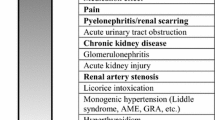Abstract
Paediatric hypertension is an increasingly common problem, but one that is under recognized and undertreated. Once the condition is accurately assessed, most children should begin therapeutic lifestyle changes (e.g. diet and exercise). If required, pharmacological treatment should be prescribed according to the needs of the individual child and the underlying cause of hypertension. Urgent acute antihypertensive therapy may be warranted in children with severe hypertension.
Similar content being viewed by others
References
Misurac J, Nichols KR, Wilson AC. Pharmacologic management of pediatric hypertension. Pediatr Drugs. 2016;18(1):31–43.
National High Blood Pressure Education Program Working Group on High Blood Pressure in Children and Adolescents. The fourth report on the diagnosis, evaluation, and treatment of high blood pressure in children and adolescents. Pediatrics. 2004;114(2 Suppl 4th Report):555–76.
Flynn J, Zhang Y, Solar-Yohay S, et al. Clinical and demographic characteristics of children with hypertension. Hypertension. 2012;60(4):1047–54.
Dobson CP, Eide M, Nylund CM. Hypertension prevalence, cardiac complications, and antihypertensive medication use in children. J Pediatr. 2015;167(1):92-7.e1.
Lurbe E, Cifkova R, Jk Cruickshank, et al. Management of high blood pressure in children and adolescents: recommendations of the European Society of Hypertension. J Hypertens. 2009;27(9):1719–42.
Juhola J, Oikonen M, Magnussen CG, et al. Childhood physical, environmental, and genetic predictors of adult hypertension: the cardiovascular risk in young Finns study. Circulation. 2012;126(4):402–3.
Chaturvedi S, Lipszyc DH, Licht C, et al. Pharmacological interventions for hypertension in children. Evid Based Child Health. 2014;9(3):498–580.
Flynn JT, Nahata MC, Mahan JD Jr, et al. Population pharmacokinetics of amlodipine in hypertensive children and adolescents. J Clin Pharmacol. 2006;46(8):905–16.
Bullo M, Tschumi S, Bucher BS, et al. Pregnancy outcome following exposure to angiotensin-converting enzyme inhibitors or angiotensin receptor antagonists: a systematic review. Hypertension. 2012;60(2):444–50.
Bitkin EC, Boyraz M, Taşkin N, et al. Effects of ACE inhibitors on insulin resistance and lipid profile in children with metabolic syndrome. J Clin Res Pediatr Endocrinol. 2013;5(3):164–9.
Wells T, Frame V, Soffer B, et al. A double-blind, placebo-controlled, dose-response study of the effectiveness and safety of enalapril for children with hypertension. J Clin Pharmacol. 2002;42(8):870–80.
James PA, Oparil S, Carter BL, et al. 2014 evidence-based guideline for the management of high blood pressure in adults: report from the panel members appointed to the Eighth Joint National Committee (JNC 8). JAMA. 2014;311(5):507–20.
Shaefer F, Coppo R, Bagga A, et al. Efficacy and safety of valsartan in hypertensive children 6 months to 5 years of age. J Hypertens. 2013;31(5):993–1000.
López-Sendón J, Swedberg K, McMurray J, et al. Expert consensus document on beta-adrenergic receptor blockers. Eur Heart J. 2004;25(15):1341–62.
Batisky DL, Sorof JM, Sugg J, et al. Efficacy and safety of extended release metoprolol succinate in hypertensive children 6 to 16 years of age: a clinical trial experience. J Pediatr. 2007;150(2):134–9.
Okeke CC, Medwick T, Nairn G, et al. Stability of hydralazine hydrochloride in both flavored and non-flavored extemporaneous preparations. Int J Pharm Compd. 2003;7(4):313–9.
Flynn JT, Tullus K. Severe hypertension in children and adolescents: pathophysiology and treatment. Pediatr Nephrol. 2009;24(6):1101–12.
Flynn J, Bradford M, Harvey E. Intravenous (IV) hydralazine in hypertensive pediatric in patients: does it work? Is it safe? J Am Soc Hypertens. 2014;8(4 Suppl):e130.
Author information
Authors and Affiliations
Consortia
Ethics declarations
The article was adapted from Pediatric Drugs 2016;18(1):31–43 [1] by salaried/contracted employees of Adis/Springer and was not supported by any external funding.
Rights and permissions
About this article
Cite this article
Adis Medical Writers. Manage paediatric hypertension with lifestyle changes and, if required, appropriate antihypertensive drugs. Drugs Ther Perspect 32, 428–433 (2016). https://doi.org/10.1007/s40267-016-0322-5
Published:
Issue Date:
DOI: https://doi.org/10.1007/s40267-016-0322-5




